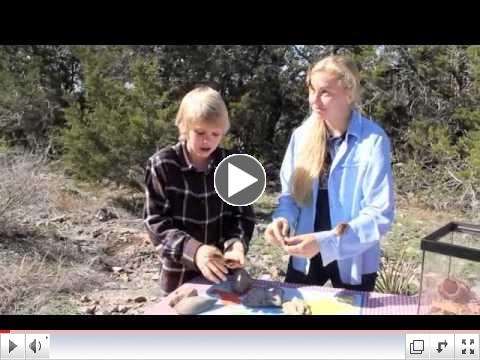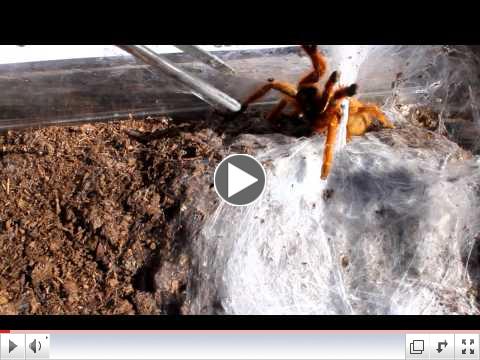Greetings!
February is the month for love, and Erik and I love our critters! Sometimes we're asked which is our favorite critter, and we honestly can't pick a favorite. They're all so interesting and cool. Our most popular critters when we're presenting to classrooms or entertaining at birthday parties are our roaches. Yes, you read that right - our roaches! In this newsletter you can learn more about pest roaches and how they're different from the roaches we keep as pets!
~Courtney |
 
Erik and I have a close friend, John Slaughter. John is a biologist and entomologist who works for Orkin. We get most of our information about insects and arachnids from John. John spends countless hours with us and helps us edit presentations. Erik and I don't like killing beneficial insects or spiders, but there are some insects that are only harmful and don't help us at all. OK - we'll say it, they are creepy! But you don't have to be afraid, because you're bigger than they are! The roaches that live in the United States are considered PESTS, and we will smash them. Roaches that are pests are different from most roaches. There are 5 main species that are pests. They carry pathogens and also have a natural excretion that can cause allergic reactions in some people. They infest our homes and spread disease. The main 5 species are the Oriental Roach (the dirtiest), American Roach (also known as Palmetto bugs or water bugs), German Roach, Brown-banded Roach, and the Smokey Brown Roach.
There are roughly 3500 roach species and MOST OF THEM AREN'T PESTS. The thousands of roach species that are not pests are not so creepy after all... and we LOVE them!! ~Courtney
|
Pest Roaches vs. Clean RoachesMost of the 3500 different species of roaches are helpful to the environment, because they eat decaying stuff. Rotting wood, plants, and fruit are all part of their diet. They help break down this material and 'recycle' it. Roaches also make a good meal for spiders, lizards, and countless other critters.
Roaches that are pests are dirty and spread diseases, but all other roaches are actually clean and don't spread diseases.
Pest roaches don't help the environment, but all other roaches are helpful.
Pest roaches can infest structures - like our houses, but all other roaches cannot infest. They must live outside in their natural habitat. We recreate hospitable habitats when keeping them as pets.
Meet some clean and helpful roaches that we keep (on purpose) at our house! Madagascar Hissing Roaches, Giant Cave Roaches, and Peppered Roaches make great pets!
 | | Madagascar Hissing Roaches Gromphadorhina portentosa |
Hissing roaches can reach up to 2-3 inches in body length and 1 inch in width. They molt about 6 times before maturing (it takes about 6-7 months). The female's gestation period is about 60 days, and they give birth to 30-60 live young. Unlike most roaches, hissing roaches do not have wings. However, since they can crawl up glass, they need a secure lid when keeping them as pets. They can live up to 5 years in captivity. Hissing roaches are indigenous to Madagascar and are terrestrial. They scavenge for rotting food on the forest floor. Hissing roaches hiss by pushing air through pores in their abdomen called modified spiracles. Modified spiracles are small openings that insects use to breathe. Hissing is used to scare predators and to communicate with each other. I like having them as pets, because they're easy to handle, don't have an odor, and are inexpensive. They don't even need special lighting or a heater. And let's face it, roaches are just downright COOL!
~Courtney
|
 | |
Giant Cave Roaches
Blaberus giganteus
|
You think Hissing Roaches are big? Giant Cave Roaches are one of the largest species of roach reaching up to 3 ½ inches long and about an inch and a half wide. They have wings, but they are too heavy to fly. These roaches have a 5-6 inch wingspan! It takes them about 7-8 molts before they mature and get their wings. They are indigenous to tropical areas of Central and South America, and the West Indies. The life span for these roaches is only a year to a year and half. Giant Cave Roaches can be found in rotting logs and hollow trees in rainforests, but they are most commonly found living in caves. Babies can often be found playing in bat guano (bat waste).
~Courtney
|
Peppered Roaches
Archimandrita tesselata
Peppered Roaches are another non-flying roach species with wings. They are a tropical roach that lives on the ground in the rainforests of Columbia, so they need to have a moist habitat. Peppered Roaches eat a variety of food, like lettuces, apples, carrots, and other fruits and veggies. We mostly feed ours dry cricket food, but sometimes we give them fruits and veggies to keep them healthy. Peppered Roaches give birth to live young, I find that very interesting considering the fact that they are not mammals. One of my favorite things about Peppered Roaches is their size! They can reach up to three inches long! ~Erik
|
Repticon
Courtney and I are very excited to announce that we've been invited to speak at the Repticon Convention in Ellis, Texas on February 18th & 19th. We have been to many reptile shows, expos and conventions, but we've never had the privilege of speaking at one! Repticon is a great place to learn more about critters like reptiles, insects, and arachnids. If you're ready to adopt a critter, don't miss Repticon! Critters are inexpensive at Repticon, and you'll have the chance to buy directly from reputable breeders. Courtney and I like to keep business cards from breeders in case we have questions after we get home with our new critter.
Whooping Crane FestivalMark your calendars for the 16th Annual Whooping Crane Festival in Port Aransas, Texas February 23rd - 26th! Courtney and I will have display tables set up from 10:00 am until 2:00 pm in the Children's Corner on Sunday at the festival. Visitors will also enjoy a butterfly tent, guided tours, an art exhibit and so much more. Register now for the guided boat tours and view endangered Whooping Cranes in their winter habitat! Don't miss this rare opportunity!
~Erik |
Valentine's Day Gift Ideas
|
| Explanation to the January Science Experiment~ |
Click on Newsletter Archive under Quick Links on the right column to view the January 2012 science experiment.
Water molecules are strongly attracted to each other and when not disturbed, the water molecules on the surface create surface tension. We have rain drops and dew because of surface tension. When soap is introduced into a bowl of water with pepper sprinkles on the surface, the surface tension is disturbed. The pepper is drawn to the sides of the bowl with the water. You can watch water bugs walk on water! They're cruising around on the water because of surface tension!!
|
|
You can help us grow Not So Creepy Critters!
Thank you,
Courtney and Erik
|
|
|
|
Quick Links
| Newsletter Archive
|
 | | About Us |
|
 | VIDEO BLOG
|
| |
For the Love of Roaches
|
| |
~Courtney & Erik
| |
 | |
Madagascar
|
Madagascar is an amazing island off the southeast coast of Africa. It is the home to many species of reptiles, amphibians, birds, insects, and mammals.
Madagascar has 200,000 different species of animals, 150,000 of those are exclusive to the island and cannot be found anywhere else on the planet!
Sadly, Madagascar has the highest number of threatened fish species in the world. Scientists believe the cause is due to a mixture of agricultural runoff and erosion on the island. Both of these factors seem to be causing a significant loss of habitat.
~Erik
|
 |
Statistics and M&Ms
Science Experiment
You'll need:
a bag of M&Ms
paper and markers
calculator
*Open bag and count M&Ms - record total
*divide M&Ms by color
*Count and record totals
*Create a graph
QUESTIONS to answer-
What's the ratio of each color compared to the total number of M&Ms?
Try the experiment with peanut M&Ms. Compare graphs. Are the results different?
|
|
  | |
Watch Mango!
|
|
Starburst Baboon Tarantula(Pterinochilus murinus)Starburst Baboon Tarantulas are indigenous to central, southern, and eastern Africa. It is also known as the Orange Baboon, Usambara Orange Baboon, Mombasa Golden Starburst, and many other names, but my favorite is the "OBT." "OBT" stands for Orange Baboon Tarantula or ORANGE BITEY THING! These beautiful critters got the name "Orange Bitey Thing," because of their extremely defensive reputation. When threatened or afraid, the OBT lifts its front legs into the threat pose- sometimes so far that it falls over backwards! While the OBT's bite is painful, it is not life-threatening...to humans at least. These tarantulas are usually a golden orange color with a starburst design on their prosoma, but there are also other color variations including the red color form, dark brown or black, and tan or gray. Scientists believe that this could possibly be because they are living on different types of soil, depending on where they are found in Africa. The Starburst Baboon Tarantula is for advanced keepers, since biting is their first line of defense. However, they are fun to keep as pets, because of their beauty and unique attitude. ~Courtney
| |
|
 | |
Purdy Unique Cakery
|
| |
Looking for something sweet for your Valentine? Contact the Purdy Girls at Purdy Unique Cakery and place your order today. Click on the photo and check out their new website for more photos & information.
|
|
 | |
Arts & Craft Store
|
Courtney and I have many talented friends. We added a new page to our website that includes photos of crafts and artwork made by friends.
Our friend, Kaitlin, makes hammocks and sleeping bags for her foster rats. These pouches can be used for rats, mice, hamsters, gerbils and ferrets!
 | | Click Photo |
Our friend, Cory, makes paracord keychains and bracelets. Paracord is also used by astronauts and the military!
|
 | | Critters for Sale |
|
Roaches for your Classroom
Now that you understand the differences between pest roaches and all other roaches, you won't be afraid to keep roach colonies in your classroom! They're clean, easy to care for, and interesting to study. Still uneasy about roaches? Consider an Emperor Scorpion or Tarantula! They're also easy and clean! Click on the photo to contact us and order your classroom critter today! ~Erik
| |
|
|
|